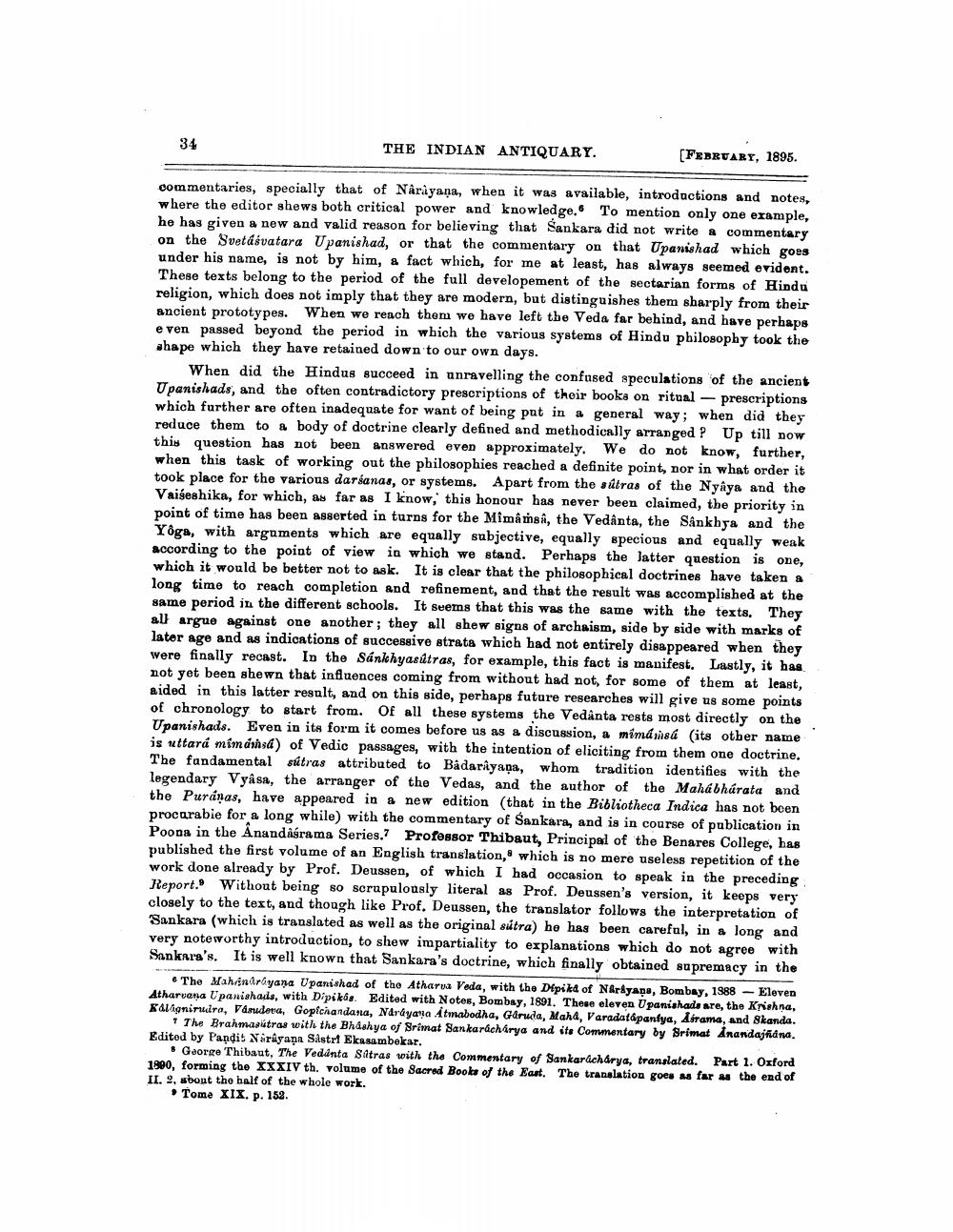________________
34
THE INDIAN ANTIQUARY.
[FEBRUARY, 1895.
commentaries, specially that of Narayana, when it was available, introductions and notes, where the editor shews both critical power and knowledge. To mention only one example, he has given a new and valid reason for believing that Sankara did not write a commentary on the Svetáśvatara Upanishad, or that the commentary on that Upanishad which goes under his name, is not by him, a fact which, for me at least, has always seemed evident. These texts belong to the period of the full developement of the sectarian forms of Hindu religion, which does not imply that they are modern, but distinguishes them sharply from their ancient prototypes. When we reach them we have left the Veda far behind, and have perhaps e ven passed beyond the period in which the various systems of Hindu philosophy took the shape which they have retained down to our own days.
When did the Hindus succeed in unravelling the confused speculations of the ancient Upanishads, and the often contradictory prescriptions of their books on ritual - prescriptions which further are often inadequate for want of being put in a general way; when did they reduce them to & body of doctrine clearly defined and methodically arranged ? Up till now this question has not been answered even approximately. We do not know, further, when this task of working out the philosophies reached a definite point, nor in what order it took place for the various darsanas, or systems. Apart from the sátras of the Nyâya and the Vaigeshika, for which, as far as I know, this honour has never been claimed, the priority in point of time has been asserted in turns for the Mimâmsa, the Vedanta, the Sankhya and the Yoga, with arguments which are equally subjective, equally specious and equally weak according to the point of view in which we stand. Perhaps the latter question is one, which it would be better not to ask. It is clear that the philosophical doctrines have taken a long time to reach completion and refinement, and that the result was accomplished at the same period in the different schools. It seems that this was the same with the texts. They all argue against one another; they all shew signs of archaism, side by side with marks of later age and as indications of successive strats which had not entirely disappeared when they were finally recast. In the Sankhyasútras, for example, this fact is manifest. Lastly, it has not yet been shewn that influences coming from without had not, for some of them at least, aided in this latter result, and on this side, perhaps future researches will give us some points of chronology to start from. Of all these systems the Vedanta rests most directly on the Upanishads. Even in its form it comes before us as a discussion, a mimdinsa (its other name is uttará mim ashs) of Vedic passages, with the intention of eliciting from them one doctrine. The fundamental sútras attributed to Bådarayana, whom tradition identifies with the legendary Vyasa, the arranger of the Vedas, and the author of the Mahabhárata and the Puranas, have appeared in a new edition (that in the Bibliotheca Indica has not been procarabie for a long while) with the commentary of Sankara, and is in course of publication in Poona in the Anandasrama Series.7 Professor Thibaut, Principal of the Benares College, has published the first volume of an English translation, which is no mere useless repetition of the work done already by Prof. Deussen, of which I had occasion to speak in the preceding Report. Without being so scrupulously literal as Prof. Deussen's version, it keeps very closely to the text, and though like Prof. Deussen, the translator follows the interpretation of Sankara (which is translated as well as the original sutra) he has been careful, in a long and very noteworthy introduction, to shew impartiality to explanations which do not agree with Sankara's. It is well known that Sankara's doctrine, which finally obtained supremacy in the
The Mahanarayana Upanishad of the Atharva Veda, with the Dipikd of Narayana, Bombay, 1888 - Eleven Atharvana Upanishads, with Dipikas. Edited with Notes, Bombay, 1891. These eleven Upanishads are, the Krishna, Kalagnirudra, Vasudora, Gopichandana, Ndrlyara Atmabodha, Garuda, Maha, Varadatápanfya, Asrama, and Skanda.
+ The Brahmasútras with the Bhashya of Srimat Sankarúcharya and its Commentary by Srimat Arandajfiana. Edited by Pandit Narayana Sastri Ekasambekar.
& George Thibaut, The Vedanta Satras with the commentary of Sankaracharya, translated. Part 1. Oxford 1900, forming the XXXIV th. volume of the Sacred Boola of the East. The translation goes as far as the end of II. 2, about the half of the whole work.
• Tome XIX. p. 152.




